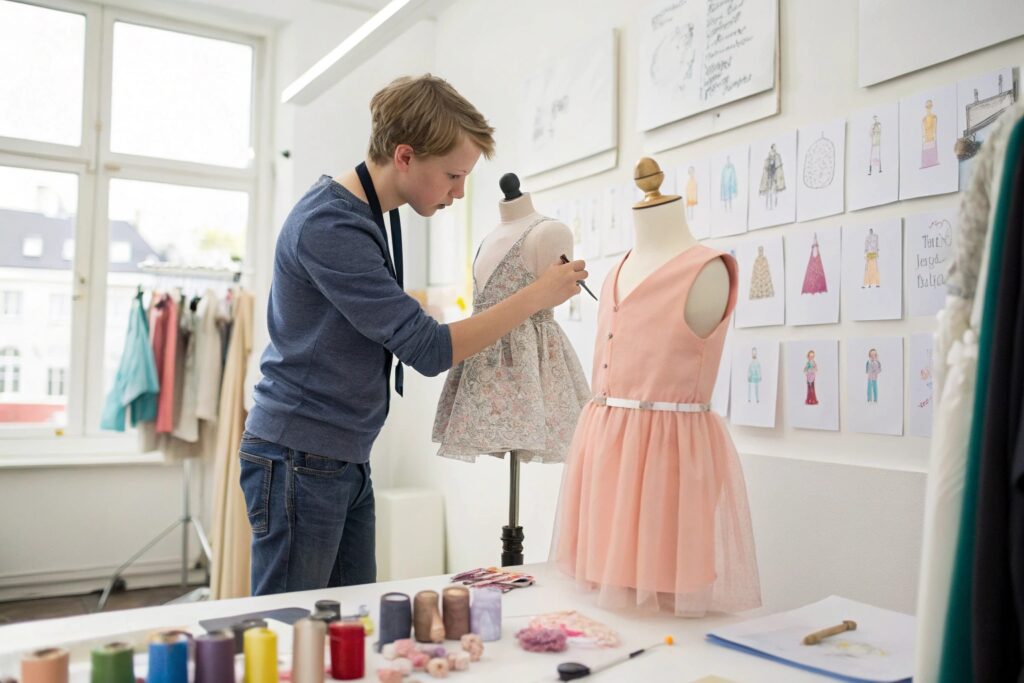Launching new products always comes with risk. Brands often overcommit, only to find out later the demand isn’t there. Capsules offer a safer way.
Brands use capsule collections to test new markets because they require less investment, allow faster feedback, and create urgency—all while building brand equity.
If you’re trying to validate a new style, fabric, or customer base without overextending your resources, capsule drops might be your most strategic move. Here’s how to do it right.
How do you test a new product in the market?
New product testing often fails because brands go too big, too fast. They manufacture full lines before getting any customer feedback.
A capsule collection is a low-risk tool to test new products by launching limited quantities to a targeted audience and tracking sales, feedback, and engagement.

How does limited quantity testing help you reduce risk and increase clarity in early-stage product validation?
Imagine launching a totally new fabric blend for kids’ winter wear. Instead of ordering 3,000 units across 10 styles, you create a mini capsule: 3 pieces in one colorway. You send samples to influencers, offer early access via email, and see what happens. Do parents rave about warmth? Or complain about static?
That data helps you decide whether to scale. If it flops, you’ve lost little. If it sells out, you now have proof. At Fumao Clothing, many clients launch capsules specifically to test new trims, silhouettes, or size ranges. They know they can go small—300–500 units—and still get insights.
How does launching a capsule improve communication with your target customer?
A capsule gives you a story to tell. Instead of a vague “new arrivals” drop, you announce something like: “The Wild Explorer Mini Capsule: Weather-Ready Layers for Cold-Climate Toddlers.” It draws attention. Buyers know what to expect. And you can ask for specific feedback.
Your sales team gets to test talking points. Your customer service team hears objections. You track returns. You review customer images. Capsules make market testing an event, not just a silent experiment.
What are the methods of market testing?
Many brands use surveys and mockups—but those don’t show real buyer behavior. Capsules offer a real-world test.
Brands can test markets through soft launches, limited drops, influencer seeding, pop-ups, and region-specific capsule releases—all designed to gather quick, actionable data.

How do soft launches and limited drops simulate real market behavior better than traditional surveys?
Traditional market research gives you opinions. But opinions don’t always translate into sales. With a capsule launch, customers vote with their wallets. They either buy it—or they don’t. That’s the real test.
For instance, one of our U.S. clients wanted to try pastel-colored fleece. They were unsure if American parents would go for it. So we helped them produce a 500-unit pastel-themed capsule—just hoodies and joggers. They ran two micro-influencer campaigns and tracked conversions. Within one week, 80% sold out. That’s way more powerful than a focus group.
How do regional capsule drops help analyze different demographics or sales territories?
If you’re unsure whether a new concept will work in different countries or even states, capsule drops are perfect. Launch the same design in two versions—one for New York, one for Austin. You’ll see which designs perform better, which pricing works, and whether your messaging resonates.
At Fumao Clothing, we often guide clients on this. We help tag SKUs by territory, track feedback, and compare metrics. A kid’s raincoat might boom in Seattle but bomb in LA. Capsule testing shows that without overcommitting inventory.
How can a firm use a test market in its new product development process?
Many brands forget to test before scaling. Capsules fix that mistake—providing fast, affordable insights.
Firms use capsule drops as controlled test markets by selecting sample audiences, measuring response, and adjusting designs before full production.

What role does sample audience selection play in successful capsule testing?
You don’t need a nationwide launch to learn. A well-selected group—such as returning customers, newsletter subscribers, or fans of a specific influencer—can provide clearer feedback than the general public.
We always recommend our clients begin with their top 5% of buyers. Send them exclusive access to the new capsule. You’ll not only get immediate revenue—you’ll get honest, engaged feedback. These buyers know your brand best, and they’re most likely to tell you what works or doesn’t.
How can data from capsule drops inform full-scale production and merchandising?
After a capsule, you’ll know what size ranges sold fastest. What prints got shared most. What SKUs got returned. You’ll also know what customers asked for in reviews or DMs.
One brand we worked with launched a summer linen set. Parents loved the look but wanted snap closures for quicker diaper changes. That detail became a standard in their next full release. The capsule showed what to fix—before they invested in 5,000 units.
The goal isn’t just selling—it’s learning. The capsule tells you what the customer cares about, so your next drop hits the mark.
What is an example of market testing products?
Real brands test capsules to avoid costly missteps and discover bestsellers they’d never predict through theory alone.
A great example of market testing is a kidswear brand using a 3-piece seasonal capsule to validate a new fit or fabric—then scaling only after proven success.

How did one of our clients validate a fleece capsule before a winter launch?
One client came to Fumao Clothing with a problem: they had sold cotton layers well but weren’t sure if performance fleece would work for their brand. Instead of a full line, we helped them build a mini capsule: one hoodie, one zip-up, one jogger.
They did a pre-order with just email subscribers. Within 72 hours, they hit 92% sell-through. Reviews were glowing—parents loved the warm but breathable texture. Based on that, the client greenlit a 10-style fleece range for winter, which became their top-performing collection.
That’s capsule testing done right: controlled launch, fast feedback, no excess risk.
How can even failed capsule drops become valuable learning experiences?
Sometimes a capsule doesn’t perform. That’s okay—if you learn from it.
Another brand we work with tested a denim toddler line. Strong styling, good pricing—but sales were soft. Post-purchase surveys revealed parents were worried about comfort and flexibility for crawling babies.
This brand adjusted their cuts and offered stretch denim in their next capsule. The second drop did 3x better. That first “failure” saved them from launching an entire product category that would have flopped on a bigger scale.
Capsule testing creates room to experiment, adjust, and grow—without gambling the entire season.
Conclusion
Capsule collections help brands test products and markets in real-world conditions—quickly, affordably, and with powerful feedback loops.










